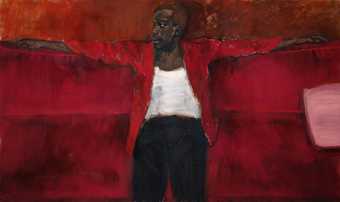
Lynette Yiadom-Boakye The Ventricular 2018 Oil paint on linen © Lynette Yiadom-Boakye, courtesy the artist, Corvi-Mora, London and Jack Shainman Gallery, New York
How do we divest ourselves of the need to make ourselves extraordinary?
-- Kathleen Collins, 1984
In The Ventricular 2018, we observe a Black, male-presenting figure in quiet, contemplative repose. Resting comfortably on what appears to be a velvet sofa, he gazes leftward, away from the viewer and into an undisclosed beyond, his arms notably outstretched, like emboldened wings, filling the entire breadth of the horizontal composition. The painting, as with most of Lynette Yiadom-Boakye’s works produced over the last decade, touches us through its quick, gestural marks and the affective intensity of its rich, chromatic palette. Saturated with a seemingly infinite spectrum of red hues – from umber and crimson to carmine and rust, which spill into the figure’s jacket and hair, as well as the sofa and pillow upon which the figure reclines – the painting’s unmistakeable colourist sensibility, spatial flatness and leisurely depiction of unspectacular, domestic inhabitation recalls a plethora of European modernist paintings produced at the turn of the 20th century – Edgar Degas’ Combing the Hair 1895, and Walter Sickert’s Two Women on a Sofa – Le Tose 1903–4, especially come to mind. Degas’ painting, similarly imbued with all-over tones of red and pink, depicts two women in an abstract interior setting, one brushing the other’s long red hair, while Sickert’s painting renders two elegantly dressed women in abstracted strokes of paint, both lying comfortably on a daybed in a darkened room.
Although I have begun with a recognisably art-historical approach, this essay, by and large, refuses and problematises the interpretive and historiographic conventions of this discipline. Too often, in attempting to locate artworks within a linear genealogy of canonised artistic production, art historians (especially those trained in the Western tradition) foreclose the disruptive capacity of certain artistic practices – those from Africa and its diasporas, for instance – whose investments in modern art history unsettle the very logics that hold ‘art history’ in place. This is all to say that I have mentioned the above art historical references not for art-historical sake but rather to critically assess what might be at stake – politically and aesthetically – in Yiadom-Boakye’s citations of European modernism, as an Afro-diasporic painter. In order to unpack the potential implications of the artist’s studied citations, we must, out of necessity, shift ‘the geography of reason’.1 In other words, we must follow the cross-cultural, transatlantic routes of colonial entanglement that have generated the conditions of existence of what we today call ‘modernism’.2
In 1895, the same year that Degas created Combing the Hair, the Ashanti (an ethnic group indigenous to what is today known as Ghana) faced off with the British in the fourth and penultimate of the Anglo-Ashanti wars. From 1822 to 1900, the Ashanti engaged in a series of militant confrontations with the British Empire, which aimed to establish full control over their territory and its resources (especially its gold). The resistant Ashanti ruler, Asantehene Agyeman Prempeh, was eventually arrested and deposed by the British and, soon after being forced to sign a treaty of protection, was expelled to the Seychelles in 1896. Following an uprising by the Ashanti in 1900, known as the War of the Golden Stool, the British responded by suppressing the rebellion and occupying the city of Kumasi. In 1902 – a year before Sickert completed Two Women on a Sofa – Le Tose – the Ashanti lost their sovereignty and officially became a British Crown colony. Euro-colonial enterprises, such as the Ashanti Goldfields Corporation (founded in 1897 and still in operation today), profited greatly from this fin-de-siècle imperial arrangement, exporting the gold extracted from dispossessed Ashanti land onto a rapidly expanding global capitalist market.
Three decades prior, in 1861, Lagos, Nigeria, was similarly annexed by the British Empire. Strikingly, at the same time, between 1861 and 1865, the United States was embroiled in a bloody civil war that was fuelled by disputes over chattel slavery. In 1863, in between these geographically distanced (yet entangled) scenes of racial and colonial violence, Édouard Manet produced one of the most discussed works in the Western modernist canon, Le Dejeuner sur l’herbe – a painting that Yiadom-Boakye subtly cites in King for An Hour 2011, wherein she queerly transposes the corporeal posture of the white female nude in Manet’s painting onto an enigmatic Black male.3
In the Western modernist canon, from Claude Monet, Joaquín Sorolla and Georges Seurat to Pierre Bonnard, Walter Sickert and Henri Matisse, one can observe a consistent thematic at work, that of leisure. These European painters typically depicted individuals, couples and large groups resting, walking or playing in intimate domestic interiors, large outdoor parks, or by the seaside – spaces of tranquillity that also abound in Yiadom-Boakye’s oeuvre. Rendering their luxuriating subjects through a visual choreography of vividly painted brushstrokes, these artists’ paintings activate in the viewer the joys of having plentiful time (and money) to spare. The material conditions of bohemian leisure are also embedded in these modernist works, as the sustained attention given to light, colour and form point to the fact that many of them were produced over extensive periods of time en plein air.
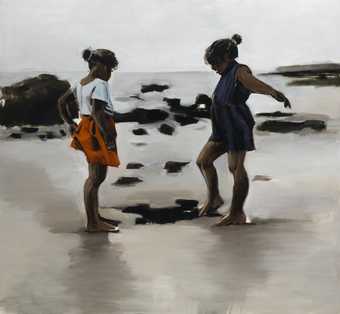
Condor and the Mole, 2011, Arts Council Collection (London, UK) © Lynette Yiadom-Boakye
But, I ask, what were the conditions of possibility for the rise of such leisure – either for the artists or the subjects they painted? Or to put it more precisely, situating these works in their economic and socio-historical context, what were the conditions of possibility for this newly emergent white European bourgeois mode of leisure? What (or who) provided the source of wealth for the generation and proliferation of these institutional markers of leisure-infused, late 19th-century European life – the café, the museum, the botanical garden, the library, the seaside resort, the ballroom – which are so ever-present in these early modernist paintings? As I and many others argue, such historically unprecedented leisure time for the Euro-American upper/middle classes was produced by a global colonised and enslaved population, who had little choice but to work, and whose exploited and expropriated lands and labour fuelled the hyper-accumulation of industrial capital that was (and still is) necessary for the enrichment of Europe and America.4 (Recall, once more, the rapid multiplication of chartered colonial enterprises at the turn of the 20th century.)
Given that the violated and superexploited racialised body haunts these Euromodernist scenes of leisure and tranquillity, what does it mean, then, for Yiadom-Boakye to figure the Black body at rest, and to do so using the very same formal techniques that index the historical, materialist inscription of racialised negation?
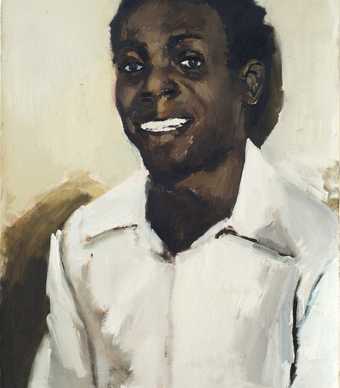
Lynette Yiadom-Boakye Elephant 2014 Private Collection © Lynette Yiadom-Boakye
In works such as Afterword 2019, Solitaire 2015, and Condor and the Mole 2011, Yiadom-Boakye does what she is known to do best. She corroborates the painterly languages of impressionism, post-impressionism and expressionism to materialise the Black figure otherwise, that is, in a manner that liberates this semiotically overdetermined and historically constructed body from the disciplining grips of temporal and geographical fixity. In doing so, I argue that Yiadom-Boakye’s painterly matterings5 of ordinary Black life disaggregate a panoply of colonial logics that consistently trap the Black subject in the impossible ontological position of what the theorist Zakkiyah Iman Jackson calls ‘plasticity’.6 According to Jackson, ‘Plasticity is a mode of transmogrification whereby the fleshy being of blackness is experimented with as if it were infinitely malleable lexical and biological matter, such that blackness is produced as sub/super/human at once, a form where form shall not hold: potentially ‘everything and nothing’ at the register of ontology’.7 For Jackson, it is not that Black subjects are denied access to the human family but rather that Black subjects are made to inhabit the status of the human on impossible terms – they are at once relegated to a position of absolute abjection and brutish savagery (the subhuman) and/or are upheld to unrealistic expectations of limitless vivaciousness, moral perfectness, and ‘Black excellence’ (the superhuman). Jackson’s theorisations of (anti-)Blackness resonate with that of the poet, playwright, and filmmaker, Kathleen Collins, who fiercely stated in a masterclass delivered at Howard University in 1984 that, ‘If you are the outsider … you are by definition extra-ordinary, meaning you are either super-good or you are super-evil. You are super-sexual or you are super-ascetic. You cannot arrive at normality because that is the one thing that has been denied you.’8
According to Collins, one of the ways for Black artists to refuse this paralysing double bind is to insist, as much as one can, on Black ordinariness – on the private, unknowable and capacious sphere of the Black subject’s inner life, wherein they think, feel and desire. Yiadom-Boakye’s moody, atmospheric paintings do just this (as did Collins in her pioneering feature-length film, Losing Ground, 1982). Rather than illustrating scenes of racial and colonial trauma or, in the inverse, providing prescriptive narratives of Black redemption and accomplishment, Yiadom-Boakye’s paintings recalibrate their focus on the mundane, depicting Black subjects lost in the leisurely, contemplative pleasures of deep thought and reflection. For example, in Afterword, rendered in an evocatively fauvist palette of pinks, yellows and greens, Yiadom-Boakye depicts a women hunched over a table, staring at a bowl of fruits, one of which she holds firmly in her hand. It is unclear how long the figure has been sitting there, but her posture seems to suggest an endless pondering or reminiscing, the psychic contents of which remain forcefully undisclosed to the external viewer.
Yiadom-Boakye does not paint portraits of ‘real’ people, a quality that sets her apart from many of the Euromodernist painters cited earlier. Despite their uncanny realness, the works’ subjects are fictitious; they are collaged inventions of the artist’s imagination, drawn from a mix of photographs, novels and lived experiences. Though these paintings elude overt historical and cultural specificities, it is difficult to ignore the subtle allusions, in both form and content, to a multiplicity of Black modernist poets, intellectuals and artists living and working around the early 20th century, especially in proximity to the Harlem Renaissance.9
Indeed, paintings such as The Matters 2016, bring to mind the enchanting eyes of writer and activist James Baldwin; Daydreaming of Devils 2016, evokes the graceful, refined comportment of dancer and choreographer Arthur Mitchell; while A Whistle in a Wish 2018, recalls writer Zora Neale Hurston’s cool yet iconoclastic presence. Akin to Yiadom-Boakye, Black modernists of the early 20th century negotiated, rather ingeniously, their complicated relationship to European modernism via selective, critical appropriations and resignifications of its forms and techniques. Afro-diasporic painters from this period, like Beauford Delaney and Bob Thompson, expressed a sincere investment in Western modernist forms but simultaneously recognised the need to unsettle and transfigure these very forms to produce hitherto unknown representational possibilities.
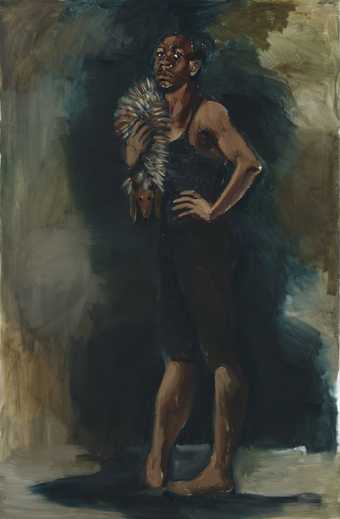
Lynette Yiadom-Boakye Solitaire 2015 Courtesy the Artist, Corvi-Mora, London, and Jack Shainman Gallery, New York © Lynette Yiadom-Boakye
Yiadom-Boakye’s oblique references to the Harlem Renaissance give further context to the queer masculinities her paintings so powerfully model. As Isaac Julien’s 1989 work, Looking for Langston, made blindingly obvious, queer networks of desire and modes of self-fashioning were at the very core of the Harlem Renaissance, and can be said to have laid the cultural and intellectual foundations for the germination of Black modernism writ large.10 In Yiadom-Boakye’s paintings, we see neither the colonial hyper-sexualisation/infantilisation of the Black male nor the reactive machismo of prior Black nationalisms, but rather an erudite, soft and self-assured Black masculinity that echoes both real and fictive Black modernist characters. For instance, ‘Smoke, Lilies, and Jade’, a ground-breaking work of decadent, modernist prose penned by writer and aesthete Richard Bruce Nugent in 1926, anticipates the thematics in Yiadom-Boakye’s works by nearly a century in its literary construction of a Black, bisexual voluptuary, Alex, who spends his days thinking, smoking, socialising and chasing after beautiful objects and people. The experimental, interior-led narrative opens as follows:
He wanted to do something…to write or draw…or something…but it was so comfortable just to lay there on the bed…his shoes off…and think…think of everything…short disconnected thoughts…to wonder…to remember…to think and smoke…why wasn’t he worried that he had no money…he had had five cents…but he had been hungry…he was hungry and still…all he wanted to do was…lay there comfortably smoking…think…wishing he were writing…or drawing…or something…something about the things he felt and thought…but what did he think…11
Though painting doesn’t bear the same relationship to interiority as literature, Yiadom-Boakye’s works signify the interiority of its Black subjects through the critical resignification of an array of modernist formal devices.12 The result, following literary theorist Kevin Quashie, is the production of ‘Black quiet’, which is none other than ‘the inexpressible expressiveness of this [Black] interior, an expressiveness that can appear publicly, have and affect social and political meaning, challenge or counter social discourse, yet none of this is its aim or essence’.13
In No Need of Speech, a large-scale painting completed in 2018, we see two Black, male-presenting figures appear against an abstract, greyish backdrop. As is typical of Yiadom-Boakye’s work, it is not clear at all where we are, but we nevertheless observe these two figures, both dressed in identical all-black unitards, kneeling on the ground and facing one another. With their hands partly enmeshed at the centre of the composition, they stare into each other’s eyes with stirring intensity. One may recall one of the final scenes in Barry Jenkins’ Moonlight, 2016, where the film’s two main protagonists, Black and Kevin, stand on opposite sides of Kevin’s kitchen, neither of them able to articulate in words the emotional gravity of loss and longing that has grown between them since their adolescent sexual encounter on a breezy Miami beach under a blue night sky. Kevin and Black allow their bodies to do all the talking – a corporeal exchange enabled by missed gazes, fidgety arms and loud silences.
Returning to No Need of Speech, neither the title nor the composition discloses what the relation between these two men is, or what either of them is thinking. The doorway to these figures’ interiority, however, is conveyed abstractly and formally through Yiadom-Boakye’s adept handling of paint. Put differently, the figures’ moods, thoughts, and desires are quietly given in the irreducibly affective, polysemous and extra-linguistic qualities of colour and painterly gesture. Looking closely, one notices Yiadom-Boakye’s colourist impulses at work – tints of red cover and surround the figures’ heads and faces, while electric dashes of blue and purple run off their backs and outline their forearms.
A Bounty Left Unpaid 2011, similarly wields colour’s semiotic and affective indeterminacy to materialise the opacity and wildness of the Black interior. In it, a Black male figure crosses what appears to be a river, his body caught in motion while hopping from one river stone to the next. The atmospheric backdrop, containing an expressive melange of brick-red, muddy green, and navy-blue washes, surrounds the male figure, both bleeding into his body and holding him in place. This collapsed, two-way relation between the foregrounded figure and the moody background suggests the illegible externalisation of the figure’s interiority. It also intimates, in line with Quashie’s thinking, that the Black interior is not an apolitical, solipsistic space cut off from the external world but rather a site of refuge, opacity and unpredictability that is shaped, but not ultimately determined, by that world.
As we’ve seen in many of the works discussed thus far, Yiadom-Boakye’s painted figures rarely ever express a concern with the viewer. Instead, in most of the works, such as To Improvise a Mountain 2018, The Woman That Watches 2015, Coagulant Dangers 2018 and For the Sake of Angels 2018, we see Black figures concerned primarily with themselves or with others who also inhabit their mundane ‘utopic’ world. Set in anonymised domestic interiors, lush grass fields and cold, wet beaches, these figures maintain their rootedness in a distanced, autonomous and non-narrativised, fictive reality.
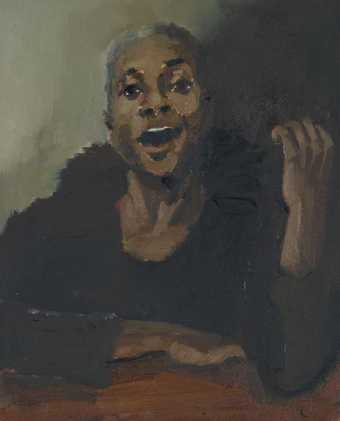
Lynette Yiadom-Boakye
Razorbill
(2020)
Tate
Such indifference to the viewer’s gaze may lead one to ask whether Yiadom-Boakye’s neo-modernist paintings materialise a distinctively Black radicalisation of what the art historian Michael Fried famously termed ‘absorption’.14 Frequently mentioned in the annals of Western art history, Fried argued that the rise of minimalist art in the 1960s (whose legacies strongly persist today) posed a threat to the sanctity of modernist art because of its reliance on ‘theatricality.’ According to Fried, it is minimalism’s theatricality – its emphasis on phenomenological contingency and thus, its experiential dependency on the beholder – that disrupts the viewer’s capacity to experience ‘instantaneousness’ and ‘presentness’, whereby the entire art object can be apprehended in ‘all its depth and fullness’ within a single moment of conviction.15 Grounding his studies in the ‘prehistory’ of modernist painting in 18th-century France, Fried notes how in many of these works, such as those by Chardin and Diderot, single figures or groups of figures are portrayed as wholly absorbed in the act of reading, thinking or listening. Absorption, Fried argues, provides the means by which modernist painting and sculpture, in absenting the beholder and secreting a ‘continuous and perpetual present’, could defeat minimalism’s insistence on theatricality.16 Though Yiadom-Boakye’s paintings do not evince a direct concern with this provincial, mid-century, Euro-American aesthetic debate, her works’ citations of Euromodernist painting implicitly traffic in the residual formal attributes of modernist absorption, which in turn produce unforeseen (and in my view, liberatory) implications when said attributes are recalibrated to figure the Black subject.
By sealing her painted figures in their own worlds – which I interpret as an act of protection and care and not one of alienation – Yiadom-Boakye refuses a long history that has consistently converted Black people into objects of spectacle, excessively available for the penetrative prodding of external gazes. Indeed, modernity’s aesthetic regimes abound with a colonial scopophilic logic that constantly attempts to denude the racialised subject of any privacy or interiority, the result of which, following poet and politician Aimé Cesaire, is the Black subject’s ‘thingification’.17 Yiadom-Boakye works against such violent logics by strategically deploying strategies of absorption, which, in forcing viewers to sit with the quiet, ordinary beauty and self-perpetuating ‘presentness’ of autonomous Black existence, undoes the racialised subject’s historical spectacularisation and structural dependency upon white recognition. Once more evoking Quashie, these paintings’ portrayals of visible but non-transparent, enigmatic but non-mythologised, Black individuals assert their ‘right to be nothing to anyone but self.’13
Yiadom-Boakye is a painter for whom the very act of painting is given primary importance. Just as Collins noted that cinema is fundamentally about ‘space and light’, from which everything else proceeds, Yiadom-Boakye grounds her majestic figurations with and through the abstract force of painterly matter.18 In a conversation from 2017, the artist discusses how her figures gradually come into view from multiple layers of paint.19 Yiadom-Boakye’s painterly surfaces evince this built-up quality through carefully positioned, compositional sections that reveal effulgent, high-contrast underpainting – see Greenfinch 2012 and Bracken or Moss 2012, for example. Through this accumulative painterly process – one that meticulously overlays tones, colours and textures to achieve rhythmic, wavering chromatic juxtapositions – Yiadom-Boakye’s paintings obtain a certain paradoxical visual effect, whereby the figures appear to inhabit both a graceful stillness and a tempered vibratory motion. Visual culture theorist Tina Campt has referred to this striking phenomenon as ‘stasis.’ Speaking on photographic images of Afro-diasporic subjects, Campt describes stasis as ‘an effortful practice of achieving balance or equilibrium among various forces’ and a ‘form of stillness in motion – a motion that, while it does not necessarily move to another place, nevertheless marks a shift in the status of the subject.’20 I would like to extend Campt’s thinking on stasis to Yiadom-Boakye’s painted images.
Stasis might allow us to ‘listen’ to the fugitive frequencies that Yiadom-Boakye’s paintings materialise. I am speaking here of the quietened ‘aliveness’, the cooled intensity of ordinary Black life that these paintings formally articulate.21 Arguably, it is no coincidence that Yiadom-Boakye paints while listening to jazz, especially the modal jazz of the late 1950s and early 1960s.22 In jazz compositions such as ‘Flamenco Sketches’ from Miles Davis’ seminal 1959 album, Kind of Blue, stasis emerges in sonic form: Paul Chambers’ and Jimmy Cobb’s repetitive drum and bass riffs, paired with Bill Evans’ spaced-out, harmonic piano chords, lay the rhythmic grounds of constraint for John Coltrane, Julian Adderley and Davis’ lyrical improvisations on the trumpet and saxophone. The misty score, as with Yiadom-Boakye’s paintings, establishes a harmonious, vibrating equilibrium that comes into being through the ‘choreosonic’ interaction of various still and motive forces.23 Consider, once more, the melodic wafting of cigarette smoke against the blue-black background in A Whistle in a Wish 2018, or the figure’s indeterminately suspended movement between two river stones in A Bounty Left Unpaid 2011.
Stasis also structures a grammar of (Black, queer) futural possibility. As has been noted, the paintings’ signature ambiguations of space and time release the Black figure from the burden of representing histories of racial and colonial subjugation and/or resistance. In remaining faithfully tethered to scenic depictions of unspectacular and ordinary Black existence, populated by figures lost in the absorptive pleasures of contemplation and leisurely sociality, these paintings allude to a future that is, in one sense, ‘not yet here’.24 This is a future in which all Black subjects, in their worldly and queer plenitude, are no longer subject to an ongoingly reproduced social calculus that immures them to ‘skewed life chances, limited access to health and education, premature death, incarceration and impoverishment’.25 Yet, Yiadom-Boakye’s painting’s generate an additional notion of futurity. They show us, by virtue of their subtle allusions to historical and contemporary Black bohemian worlds, that Black ‘futures’ exist now and have always existed. Futurity here connotes a quotidian practice of living otherwise: an improvised mode of self-liberated living that manifests as a critique of the constraining forces of the present, and in turn, as a prefiguration of the possible.26
In Amaranthine 2018, four young Black men, all topless and wearing black trousers, calmly stand in close proximity to each other. Two of them look downwards, one looks to the side, but one looks forward, his gaze directed beyond rather than at the viewer. The title of the painting means undying or everlasting, a fitting description of the figure’s soft, enduring gaze and of the timelessly rendered people in countless other works who may finally acknowledge us once our world more closely resembles theirs.
